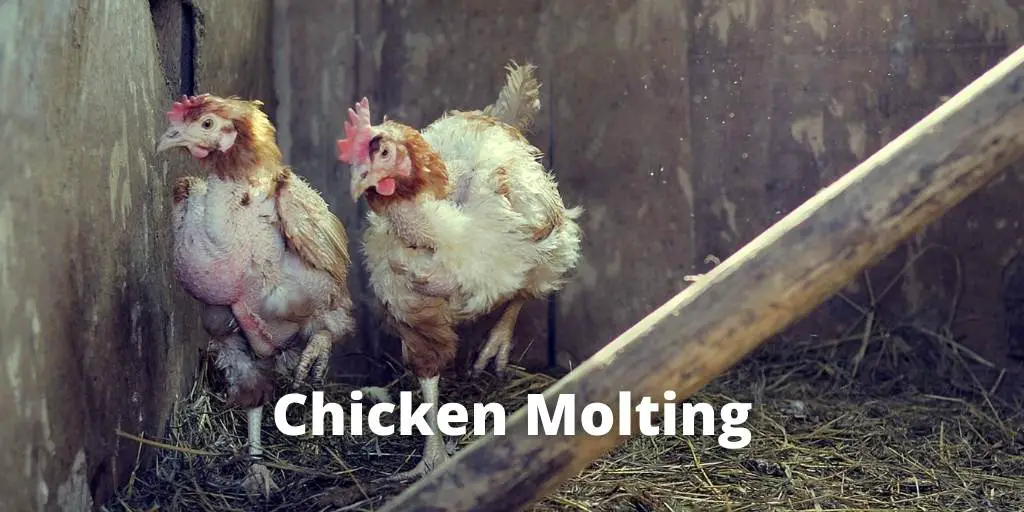Do you want to know all about chicken molting? Every poultry farmer is concerned when their flocks are in the molting process.
So, should you worry about it? This definitive guide on chicken molting comprises the various causes of the molt, symptoms, how to prevent it, treatment, and FAQs.
Whether the chicken molting is a mite infestation or seasonal, we must find the root cause and treat it immediately. Let’s start the guide to understand more about it.
Also read: How to keep chicken warm in winter?
What is Chicken Molting?
Molting is how chickens shed old feathers and grow new ones. Chickens usually molt once a year, but in some cases, they can occur more often if the chicken is stressed or ill.
Chicken molting is a three-stage process that starts with a rest period, then they lose their feathers and then grow new ones after resting again.
The chicken molting time varies from one chicken to another and from breed to breed. It could last from three weeks to five months, depending on many factors, such as the environment, diet, stress, etc.
Even though molting may seem like your chicken’s season has changed, remember that chickens lay eggs all year round, just not always at the exact times.
Also read: List of best egg-laying chickens
Common Causes of Chicken Molting
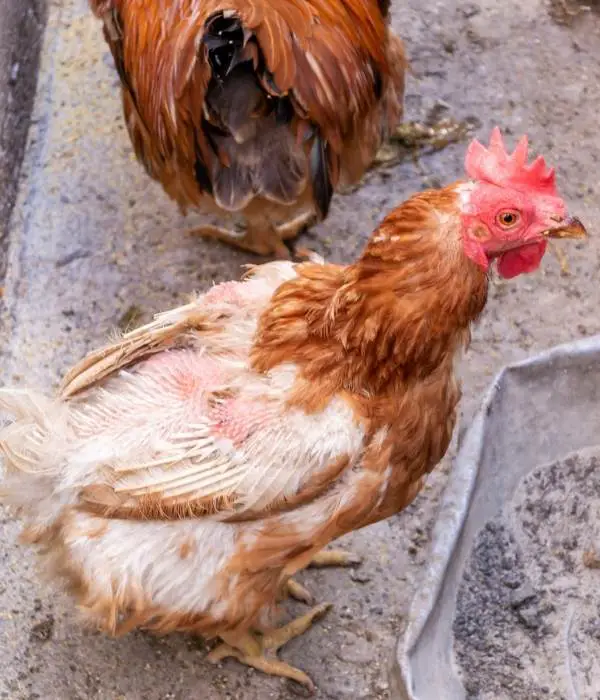
1) Hormonal Fluctuations and Abnormalities
Some chickens may molt at younger ages than others because of abnormalities and imbalances in hormone levels. Tumors in the pituitary gland or ovaries are common reasons.
2) Diet
If you feed your chickens low-quality food that doesn’t have enough nutrients, they’ll molt. If you constantly feed your chickens with low-quality food lacking nutrients, they will molt and die.
Provide them with high-quality chicken feed or any other balanced layers or breeding feed containing a high protein and amino acid level.
Additionally, commercial diets are available for molting purposes, but it is best to consult your vet about the best suitable for your case.
Also read: All about chicken scratch feed
3) Illness
Most of the chickens also molt when they are sick or stressed. The droopy appearance and loss of appetite are signs of illness in chickens. In this case, you should consult a veterinarian to rule out any possible diseases.
4) Starvation
If you don’t feed your chickens regularly, they will molt due to starvation. It is important to provide your chickens with the correct amount of feed.
Feeding chickens with less feed can cause health issues like weakness, molting, and low egg production. Giving flocks a high amount of food can lead to obesity and other leg problems.
5) Temperature fluctuations
If your flock is exposed to temperature fluctuations, it causes stress and Molting; this is especially evident if you move the chicken from a warm climate to a cold one or vice versa or extreme weather changes in general.
Chickens need their bodies to be around 105–107 degrees Fahrenheit and should always be kept dry and out of rain or snow. You can use heat lamps or place heat pads under their coop during cold days.
6) Genetics
Some breeds, such as Orpingtons and Brahmas, tend to go into molt. They start molting at young ages and usually lose once a year.
Genetics play a significant role in this case as there’s not much you can do about it as they will always go into molt under some conditions.
7) Lack of Protein
In general, if your chickens don’t get enough protein, they may go into molt early because their bodies tell them there is a lack of proteins and therefore needs replacing.
Chickens require a lot of protein but should come from high-quality sources such as seeds, legumes, or insects since they contain even more amino acids than meats.
8) Parasites
Parasites are another reason for molting, especially if chickens have weak immune systems or diets.
Chickens with a robust immune system may live with parasites without getting sick, but you can see this in older chickens about to go into molt. You must treat chicken wormer medicines as soon as possible before it becomes fatal.
Read more: About chicken dewormers
Symptoms of Chicken Molting?
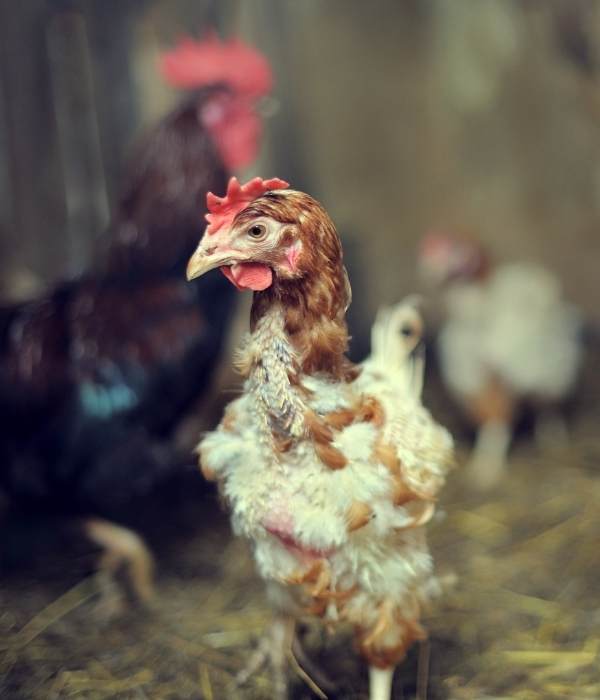
The symptoms of molting chicken are the following:
1. Thin Appearance Due to Lack of Feathers
Falling of excessive feathers leads to injury in bushes and fencing. When molting begins, you should put your chickens in a larger coop, as they will be less mobile and prone to injuries.
You can also provide them with additional food and nutrients, as they will need energy stores since their metabolism speed drops.
2. Droopy Appearance
When your chickens start molting, their feathers become weak and look droopy. This is expected, especially if the molt started due to illness or stress.
You can see them on older hens. Drooping wings and tails are signs of weakness and sickness that must be addressed by moving them into a warmer environment or calling a vet.
If you don’t start treatment immediately, their conditions may worsen, and they may die from complications like infections.
3. Lack of Feathers
Especially if your chickens are molting for reasons apart from genetics, they will lose their feathers exceptionally quickly. It is important to start noticing it on the wings and tail since these contain the most visible body parts.
If the molt is severe, your chickens will eventually become completely naked or look like puffballs.
4. All-Over Color Change
If your chicken molts regularly, even if only once a year, you should notice their colors changing entirely. Different breeds go into molts at different times.
Some individuals are predominantly white, while others may appear lighter brown or almost grayish. Make sure to consult your vet if their colors change, as it may be a sign of illness or other complications.
5. Weakness
The chickens that go into the molting process will feel tired and less active than usual when they do it. Their bodies are trying to shut down all systems except those needed for essential life support such as breathing and circulation.
The molting period can last from one month up to six months, depending on the breed and the reason they started molting in the first place.
Some hens may also stop laying eggs while they’re molting, but others don’t, so you won’t notice any changes until the feathers start falling out, and they start growing again.
When Do Chickens Molt?
Chickens usually molt in the late summer or early fall; this is the most common time to see chickens molting as they go into their natural resting period, which can last up to six months for some breeds.
Chickens you breed for meat will molt more often than those that lay eggs, but genetics also play a significant role when your chicken decides it’s time to start molting.
How Often and Long Do Chickens Molt?
It depends on the breed and why they are molting. Some may go into molt a few times a year, while others only once every three years.
When chickens start molting at young ages, it’s usually due to stress or lack of minerals in their diet for less than one year.
Genetic hens will only lose once when they reach two years old, but this can be extended if they become ill or stressed for other reasons.
The molting process can last from a few weeks to six months; some hens will start laying eggs again before molting is complete, while others may stop altogether.
In this case, providing your chickens with an enriched diet, including more minerals and protein, is best to regrow their feathers faster and feel better when going into molt.
Can You Avoid Molting Chickens?
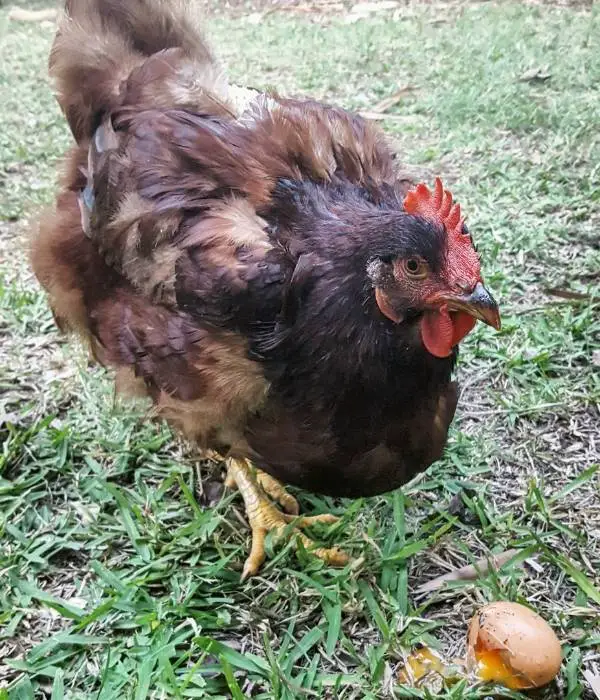
Molting is inevitable. Even if you are doing everything right, your hens will still go through the molting process every year.
It is natural for birds to molt once a year when they shed off their feathers periodically to maintain good body health.
Your chicken will look less healthy with many loose feathers hanging around during the molting season but don’t worry. As long as you provide them with good nutrition, they will grow new feathers quickly.
5 Tips to Take Care of Molting Chickens (Summer, Spring, and Winter)
Here are some easy steps for caring for your backyard boys and girls during the molting process-
1. Provide Plenty of Light and Fresh Air for Your Hens
Lack of fresh air or darkness will cause the molting process to last longer because the absence of light deprives your chicken of producing hormones triggered by sunlight responsible for the proper molting cycle.
Be sure to allow enough natural lighting sources, with at least 8 hours of daylight from a window.
2. Reduce Stress for Your Chickens
To avoid stress, decrease the number of chickens in a poultry coop and provide enough space for each chicken to stretch their wings.
Also, ensure no predators around your chickens, such as hawks and foxes, during the molting period because they can easily harm your chickens due to poor feather conditions.
Use a best electric fencing around your chicken coop to protect your flock from outside predators.
3. Adequate and Balanced Feed
Provide your chickens with balanced and nutritional feed during the molting period. You can feed them with layer pellets or mash, specially designed to meet the requirements of molting chickens.
Don’t overfeed your chicken so that it will not get obese during the molting process.
4. Give Your Chickens Vitamin Supplements
Since the molting process takes lots of energy, vitamins such as Vitamin A, D3, E, and B will be helpful to reduce the risk of any disease that can harm your chicken’s health down the road when they are still weak to lack or absent of feathers.
Also read: Best vitamins and mineral supplements for chickens
5. Provide Cozy Environment for Your Chickens
Chickens need a warm place to sleep while going through molting because their body will generate lots of heat during this time to help new feathers grow faster.
Also, provide your chickens with enough space to snuggle under the bedding materials such as straws and dried leaves to prevent them from catching a cold, significantly if you raise them in a colder climate.
Chicken Molting Diet: What to Feed Molting Chickens?
The molting process is very stressful for chickens because their bodies go through a regeneration phase, requiring certain nutrients to help them grow intensely rather than weak.
Providing your chickens with nutritional pellets, vegetables, and grains will help improve their health while waiting for the molt period to pass.
It’s best to consult your vet about what type of food they should receive during this process, but avoiding corn, wheat, or cereals is recommended since it can cause discomfort.
Creating an enclosed space in your coop where your chickens can roll over in dust will help them to improve their feather quality.
This is because it provides them with a good source of minerals and removes any crusty patches which may have appeared under their feathers due to skin damage.
Stop using this method once the molting process is over since these baths are drying for the skin and might cause constipation if used excessively.
Chicken Molting or Sick: How to Identify?
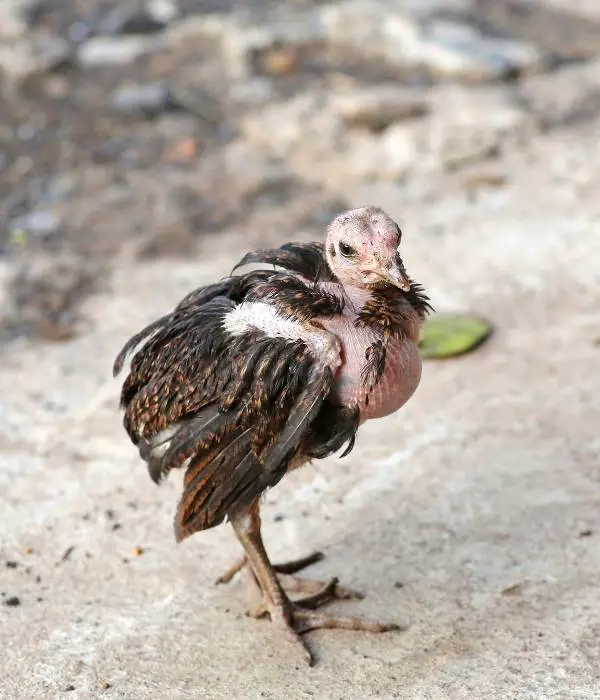
A hen’s molting is not something to worry about if you manage it adequately. However, if you notice irregularities in your hen’s behavior or the feathers are falling out quickly, it might be necessary to contact the vet since she might be sick.
Immediately isolate any chickens behaving strangely and check them for signs of mites or lice infestation.
Molting occurs once a year for chickens; however, if molting happens twice or more, you need to consider that there might be some other cause like stress, nutrition problems, or disease.
Please consult your vet for further recommendations on how to take care of your chicken during this delicate period without disrupting her molting process.
Chicken Molting or Mites
Multiple factors, including stress, diet change, illness, and aging, can cause chicken molting.
If those symptoms last longer than usual, then there is a possibility that they’re suffering from parasites such as scaly leg mites, red lice, or poultry louse, which need immediate treatment. In case of doubt, always contact a vet for a proper diagnosis and treatment.
Mite infection is difficult for chickens since it’s usually resistant to standard drugs. Checking them regularly is recommended to prevent further damage and prepare for an eventual mites infestation, which can lead to death if left untreated.
Conclusion
Molting is a natural process for chickens where they lose their feathers to get new ones.
Don’t panic if your chickens are molting because it only occurs once a year, and the process doesn’t take more than five months.
However, if you notice signs of illness or irregularities, contact your vet immediately. I hope you liked this informative guide on chicken molting.
